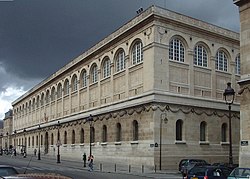Henri Labrouste
Henri Labrouste (born May 11, 1801 in Paris , † June 26, 1875 in Fontainebleau , Département Seine-et-Marne ) was a French architect and pioneer of iron construction .
Live and act

Labrouste was the youngest child of the politician François-Marie Labrouste (1762-1835), a member of the Council of Five Hundred and his wife Anne-Dominique Gourg (1764-1851). His siblings were Étienne (1792–1858), Alexandre (1796–1866), Marie-Anne (1797–1885) and Théodore (1799–1885).
In 1819 Labrouste came to Antoine Vaudoyer's (1756–1846) studio , and later moved to Louis-Hippolyte Lebas (1782–1867). With the support of his teachers, he was able to study at the École des Beaux-Arts (EBA) and at the Académie royale de peinture et de sculpture . On the occasion of the annual exhibition, Labrouste was awarded the Grand Prize for Architecture in 1824 . Associated with this was a scholarship to study at the Académie de France à Rome ( Villa Medici ).
In November 1824 Labrouste traveled to Rome and was looked after by the director Pierre Narcisse Guérin . On his outward journey, Labrouste visited several Italian cities to study their architecture. One of his most important publications from this period were his drawings of the Temple of Poseidon at Paestum . In 1830 he returned to Paris and was able to open his own studio on August 1st of the same year.
Labrouste married Marie-Joséphine Dassys (1804–1898) and had five children with her: Anne Marie (1838–1925), Charles François (1840–1841), François Émile (1843–?), Pierre Francois (1846–1907) and Laure (1848-1938).
In 1829 he became inspector of work on the Palais des Beaux-Arts in Paris. On July 28, 1835, Labrouste was seriously injured on Boulevard du Temple . He was one of the victims of Joseph Fieschi , who had committed an assassination attempt on King Louis-Philippe I there.
After his recovery and some smaller assignments, Labrouste created a hospital in Lausanne in 1837 and between 1843 and 1850 the Sainte-Geneviève library in Paris. From 1862 (completed in 1868) he created the building of the National Library , the interior structure of which has long been the main model for many similar buildings.
On November 23, 1867, the Académie des Beaux-Arts appointed Labrouste to succeed Jakob Ignaz Hittorffs , who died on March 25 of the same year.
reception
In contrast to other architects of his time, such as Gottfried Semper , who largely rejected the visible use of the new material iron or only considered it appropriate in "lesser" buildings such as industrial buildings or train stations, Labrouste shows undisguised iron architecture in his two Paris library buildings.
Honors
- 1824 Prix de Rome of the Académie Royale
- 19 January 1842 Knight of the Legion of Honor
- 22nd January 1852 Officer of the Legion of Honor
- The rue Labrouste in Paris ( 5th arrondissement ) was named in his honor.
Student (selection)
|
|
|
Works (selection)
- 1843–1850 Library of Sainte-Geneviève , Paris
- 1860 Villa Thouret, 68 Boulevard Bourdon, Neuilly-sur-Seine
- 1862–1868 Reading rooms in the old building of the French National Library on Rue de Richelieu, Paris
Fonts (selection)
- Notes recueillies et classées . Paris 1928.
- L'analysis des séismogrammes (Mémorial des sciences physiques; Vol. 26). Gauthier-Villars, Paris 1934.
literature
- Corinne Bélier et al. a. (Ed.): Henri Labrouste. Structure brought light . MOMA, New York 2012, ISBN 978-0-87070-839-8 (also catalog of the exhibition of the same name, Museum of Modern Art , March 10 to June 24, 2013).
- Renzo Dubbini (Ed.): Henri Labrouste. 1801-1875 . Electa, Milan 2001, ISBN 88-435-9634-9 .
- Frédéric Edelmann: Baltard et Labrouste. Orfévres de la Fonte . In: Le Monde , October 28, 2012.
- Giselher Hartung: Iron constructions of the 19th century . Schirmer / Mosel, Munich 1985, ISBN 3-921375-70-3 .
- Neil A. Levine: Architectural reasoning in the age of positivism. The Neo-Grec idea of Henri Labrouste's "Bibliothèque Sainte-Geneviève" . Dissertation, University of Yale, New Haven 1975 (4 vol.)
- Renée Plouin: Henri Labrouste. Sa vie, son œuvre . Dissertation, University of Paris 1965.
- Pierre Saddy (Ed.): Labrouste, architecte. 1801-1875 . CNMHS, Paris 1977 (also catalog of the exhibition of the same name, Hôtel de Sully , Paris 1976)
- David van Zanten: Designing Paris. The architecture of Duban , Labrouste, Duc et Vaudoyer . MIT Press, Cambridge 1987, ISBN 0-262-22031-8 .
Individual evidence
- ↑ published Paris 1878.
| personal data | |
|---|---|
| SURNAME | Labrouste, Henri |
| BRIEF DESCRIPTION | French architect |
| DATE OF BIRTH | May 11, 1801 |
| PLACE OF BIRTH | Paris |
| DATE OF DEATH | June 26, 1875 |
| Place of death | Fontainebleau |
